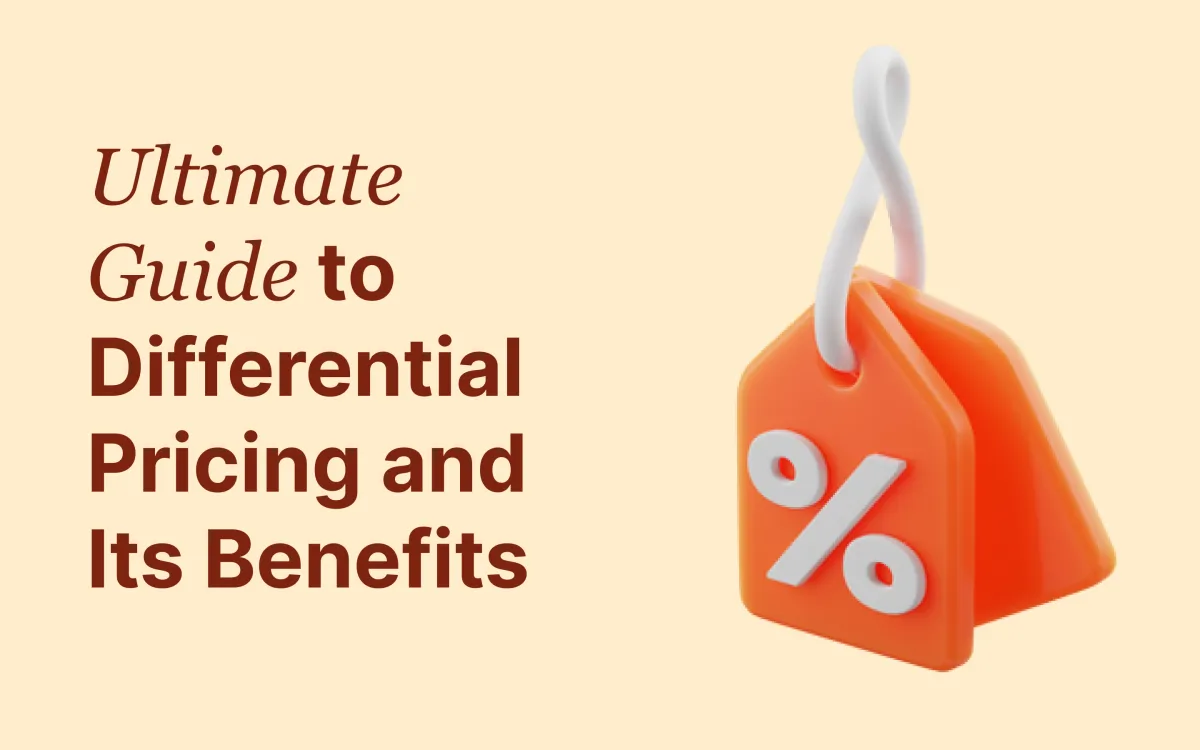Ultimate Guide to Differential Pricing and Its Benefits
Learn the benefits and strategies of differential pricing with our guide. Understand market research, data analytics, and dynamic pricing models.

After getting approval from your key stakeholders, how do you create a solid pricing strategy for your product?
Finding the right price is challenging but important for your product's success.
If the price is too low, you risk undermining the effort put into developing the product. If the price is too high, customers might turn to competitors, increasing your churn rate.
Here's how to avoid these pitfalls and develop a differential pricing strategy that benefits both you and your customers.
Definition of Differential Pricing
Differential pricing means charging different prices for the same product to different customers. This approach helps businesses operate more efficiently and increase revenue by meeting customer demand.
Companies set different prices based on customer groups, addressing various needs and willingness to pay. Prices are adjusted based on market demand and supply, allowing flexibility. Prices can change over time to stay competitive and optimize profits.
Adjusting prices regularly is important. This pricing strategy practice ensures businesses can offer different prices for the same product to different customers.
By analyzing pricing, costs, and profits, companies can find the best way to maximize revenue and satisfy customer needs.
Importance of Differential Pricing in a Business Strategy

Differential pricing is an important part of many business strategies. It helps companies create their pricing to different customer needs and market conditions.
Here’s why businesses adopt and use differential pricing strategies:
1. Maximize Business Profits
By charging different prices to different customers, businesses can increase their overall revenue.
For example, those willing to pay more can be charged higher prices, while discounts can attract price-sensitive customers. This approach makes sure that businesses get the most profit from each customer segment.
2. Attract More Customers
Offering a variety of prices makes products or services accessible to a broader range of customers.
For example, students, seniors, and bulk buyers might get special discounts, encouraging them to purchase more. This inclusivity can help businesses reach a larger audience.
3. Responds to Market Demand
Prices can be adjusted based on demand. For example, prices can be higher during peak seasons or lower during off-peak times. This flexibility allows businesses to manage their inventory better and reduce the risk of overstocking or understocking.
4. It Encourages Customer Loyalty
Special pricing for loyal customers can enhance customer retention. For instance, loyalty programs or member discounts can make customers feel valued and encourage repeat purchases.
Challenges and Risks of Differential Pricing

a. Customer Perception
Managing customer expectations and potential backlash is crucial when implementing differential pricing. Customers may feel dissatisfied if they discover they are paying different prices for the same product or service.
This dissatisfaction can result in negative feedback, such as bad reviews or social media complaints. Trust in the brand may decrease, causing customers to be less likely to return.
Additionally, loyal customers might switch to competitors if they believe they are not getting the best deal. For example, a customer buying a plane ticket may be upset if they find out someone else paid less for the same seat.
b. Regulatory Issues
Understanding legal considerations and compliance is essential in differential pricing. Failure to comply with various laws and regulations can lead to significant legal issues. Companies may face fines and penalties for non-compliance with pricing laws.
Legal disputes may arise if customers or competitors believe pricing practices are unfair or discriminatory. These legal problems can also harm the company's reputation and public image. For instance, in some countries, charging different prices based on gender or race is illegal and can lead to lawsuits.
c. Implementation Complexity
The technical and operational challenges in adopting differential pricing are significant. Implementing differential pricing requires complex technical systems and processes.
Businesses must ensure their pricing algorithms and systems are accurate and secure. Operationally, they need to train staff and develop procedures to manage differential pricing effectively. These challenges can be time-consuming and costly, requiring substantial resources and expertise to address.
How Differential Pricing Works

As mentioned earlier, differential pricing lets you charge different prices for the same product. This strategy, also called price differentiation or dual-pricing, depends on factors like location, time of day, season, and your brand or product.
Differential pricing is common in services and eCommerce, but many manufacturing companies also use it to set prices based on customer preferences. Here are some practical tips for using differential pricing.
Key Factors in Differential Pricing

a. Location
Prices may vary based on where the customer is located. Businesses often adjust prices due to different operating costs and market conditions in various locations. For example, a product might cost more in a city than in a rural area because of higher rent, wages, and other expenses in urban areas.
Price monitoring can also differ between countries due to taxes, import duties, and local economic conditions. For instance, a smartphone might be cheaper in the U.S. than in Europe due to different tax structures and market demands. Additionally, some regions might prefer certain products more than others, allowing businesses to charge higher prices where demand is stronger.
b. Time of Day
Prices can change depending on the time of day to reflect varying levels of demand. For instance, movie tickets are often cheaper for matinee shows than for evening shows because fewer people attend during the day.
Similarly, restaurants might offer lunch specials at lower prices compared to dinner prices to attract more customers during off-peak hours. This strategy helps businesses maximize their revenue by adjusting prices according to demand patterns throughout the day.
c. Season
Prices can fluctuate with the seasons. Products that are in high demand during certain times of the year often see price increases.
For example, air conditioners may cost more during the summer when demand is high. Conversely, winter clothing is typically more expensive during the colder months. Seasonal pricing helps businesses capitalize on peak demand periods and manage inventory more effectively.
d. Brand or Product
Well-known brands can often charge more for their products compared to lesser-known brands. This is because established brands have built a reputation for quality and reliability, which allows them to command higher prices.
For example, a pair of sneakers from a popular brand like Nike or Adidas will generally cost more than a similar pair from a lesser-known brand. Additionally, unique or premium products within a brand can be priced higher due to their special features or limited availability.
Practical Tips for Using Differential Pricing

a. Understand Your Customers
Know your different customer segments and what they are willing to pay. This helps create prices to meet their needs. For example, students might prefer lower prices, while business professionals might pay more for premium features. Understanding these preferences allows you to set prices that attract each group effectively.
b. Analyze Market Conditions
Keep an eye on market demand and supply to adjust prices accordingly. Higher demand can justify higher prices, while lower demand might require discounts. For example, if a product is in high demand during the holiday season, you can increase prices. Conversely, during off-peak times, offering discounts can help maintain sales.
c. Monitor Competitors
Watch your competitors' pricing strategies. This helps you stay competitive and avoid losing customers to better-priced alternatives. For example, if a competitor lowers their prices, you might need to adjust your prices to remain attractive to customers. Regularly checking competitor prices ensures you stay informed and responsive to market changes.
d. Use Technology
Use pricing software to track and adjust prices in real time. This ensures your prices are always optimized. Pricing tools can analyze market trends, competitor prices, and customer behavior to suggest the best prices. By using technology, you can make quick adjustments and stay competitive without manually monitoring prices constantly.
e. Communicate Clearly
Make sure your customers understand why prices vary. Transparency builds trust and helps avoid confusion or frustration. For instance, clearly explain seasonal discounts, location-based pricing, or special offers. When customers know why prices differ, they are more likely to accept and appreciate your pricing strategy. This openness can lead to better customer relationships and loyalty.
Types of Differential Pricing

a. Time-based pricing
Time-based pricing involves adjusting prices based on when a purchase is made. Businesses use this strategy to manage demand and maximize revenue. For example, early bird discounts allow customers who buy tickets or book services early to get lower prices.
Booking a flight months in advance is usually cheaper than booking just before the departure date. Similarly, prices vary depending on busy or slow times. Movie theaters often charge less for matinee shows and more for evening shows.
b. Market-based pricing
Market-based pricing involves setting prices based on current market conditions. Businesses look at factors like demand, competition, and economic trends to determine prices. For example, dynamic pricing is used by online retailers and ride-sharing services, where prices change based on real-time demand and supply.
During high demand, prices go up; during low demand, prices go down. Competitive pricing involves adjusting prices based on what competitors are charging. If a competitor lowers prices, a company might do the same to stay competitive.
c. Customer segment-based pricing
Customer segment-based pricing means charging different prices to different groups of customers. This strategy considers the unique needs and willingness to pay of various customer segments. For example, many businesses offer lower prices to students and seniors.
Museums and movie theaters often have special rates for these groups. Loyalty programs are another example, where regular customers might get discounts or special offers. A coffee shop might give a free drink after a certain number of purchases.
d. Volume-based pricing
Volume-based pricing, also known as bulk pricing, involves offering discounts to customers who buy large quantities of a product. This encourages larger purchases and can help businesses move inventory quickly.
For example, retailers often get lower prices from suppliers when they buy in bulk. Buying 100 units of a product might cost less per unit than buying 10 units. Subscription plans are another example, where customers who subscribe to a service for a longer period might pay less per month than those who subscribe monthly. A yearly subscription to a magazine is often cheaper than buying individual issues each month.
Examples of Differential Pricing in Action

1. Airlines
Airlines charge different prices for seats on the same flight based on factors like booking time, seat class, and demand. Early bookings are often cheaper, while last-minute bookings cost more.
2. Hotels
Hotel room rates vary depending on the season, day of the week, and demand. Rooms are usually more expensive during holidays and weekends.
3. Software Subscription
Software companies offer different pricing plans based on the features included, the number of users, and the subscription length. Basic plans are cheaper, while advanced plans with more features cost more.
Conclusion
Implementing differential pricing requires careful planning and execution. By conducting thorough market research, using data analytics, adopting dynamic pricing models, and effectively communicating with customers, businesses can navigate the challenges and risks associated with differential pricing.
These strategies help ensure that prices are set fairly and transparently, benefiting both the business and its customers.
Frequently Asked Questions
1. What are pricing differentials?
Pricing differentials are the differences in prices for the same product or service when sold in different places, to different customers, or at different times.
2. Which is the best example of differential pricing?
The best example of differential pricing is airline ticket pricing. Airlines charge different prices for the same seat on a flight based on factors like booking time, demand, and seat class.
3. What is pricing differentiation?
Pricing differentiation is the strategy of charging different prices for the same product or service based on certain criteria like customer segments, purchase locations, or times. This allows businesses to maximize their revenue by adjusting prices according to demand and customer willingness to pay.
4. What is the meaning of differential cost pricing?
Differential cost pricing means setting the price of a product or service based on the additional cost of producing one more unit. This pricing approach considers the extra costs incurred for producing and selling an extra item, which helps businesses decide the minimum price at which they can sell the product without losing money.
